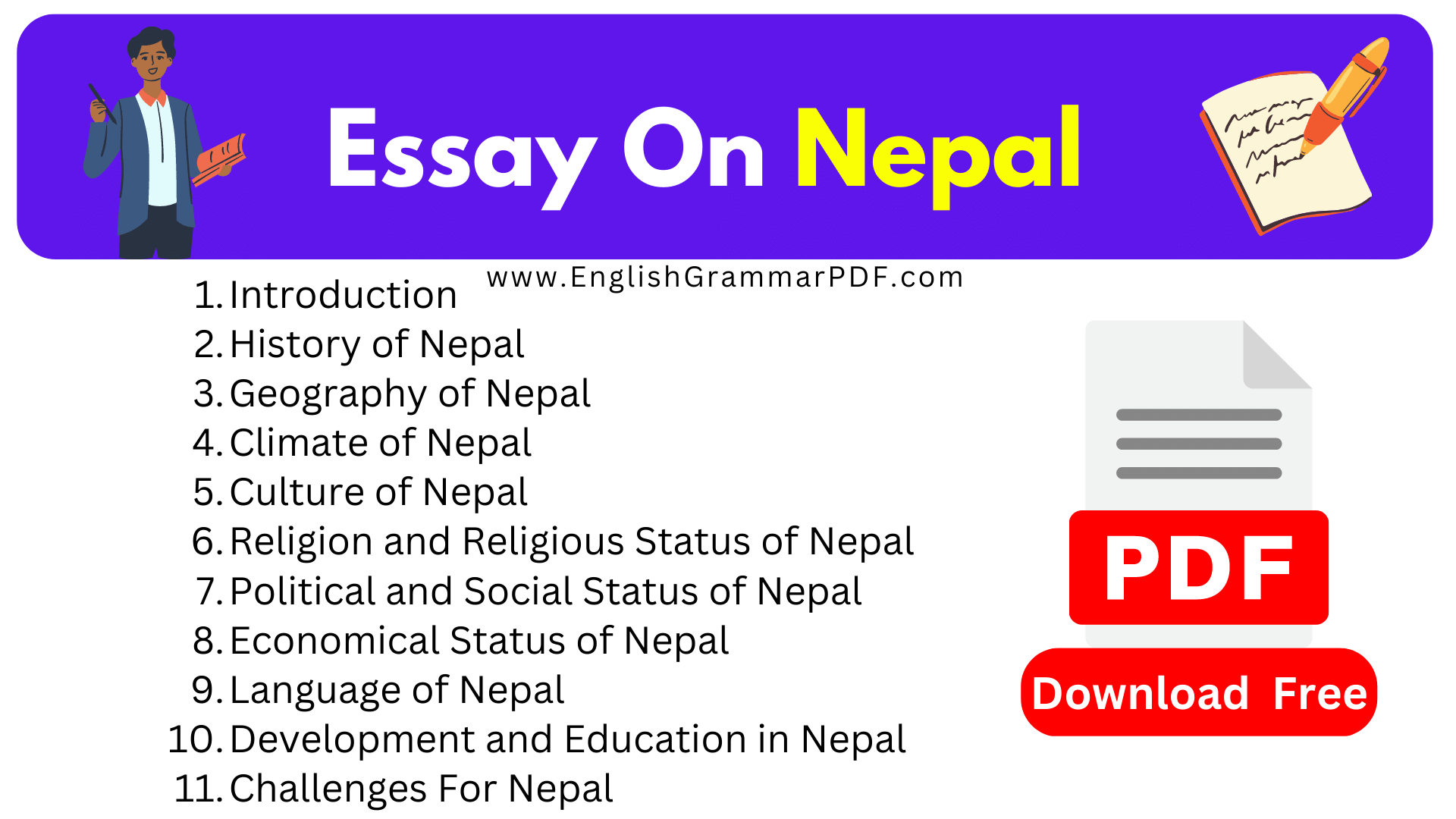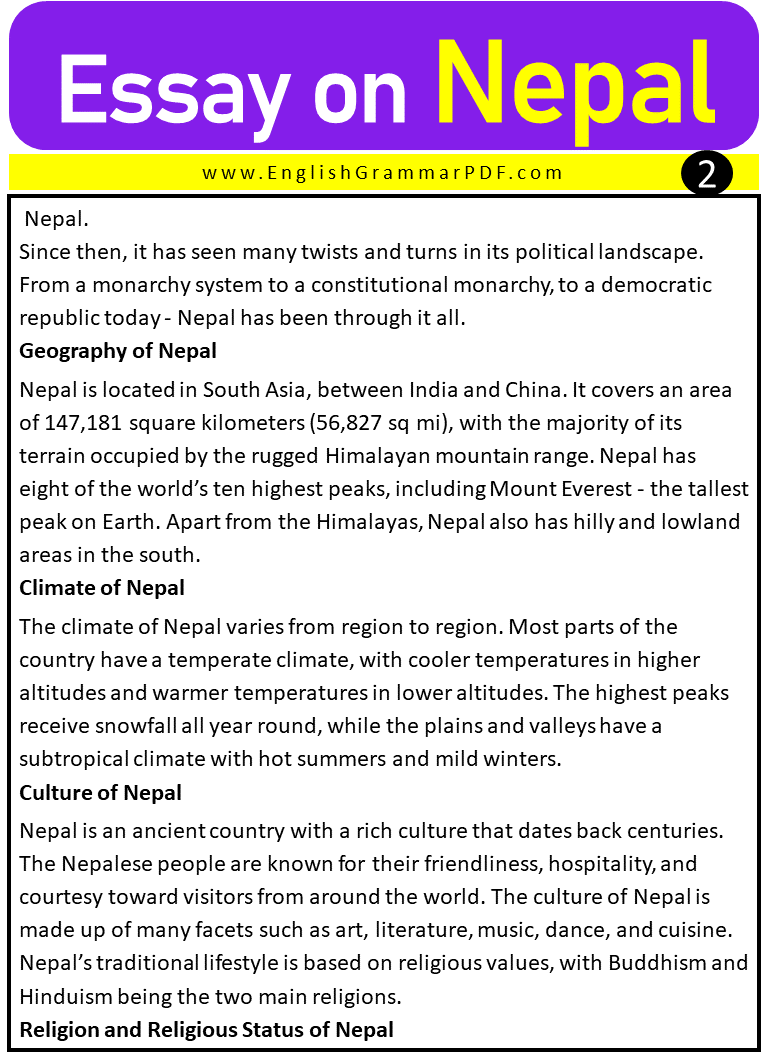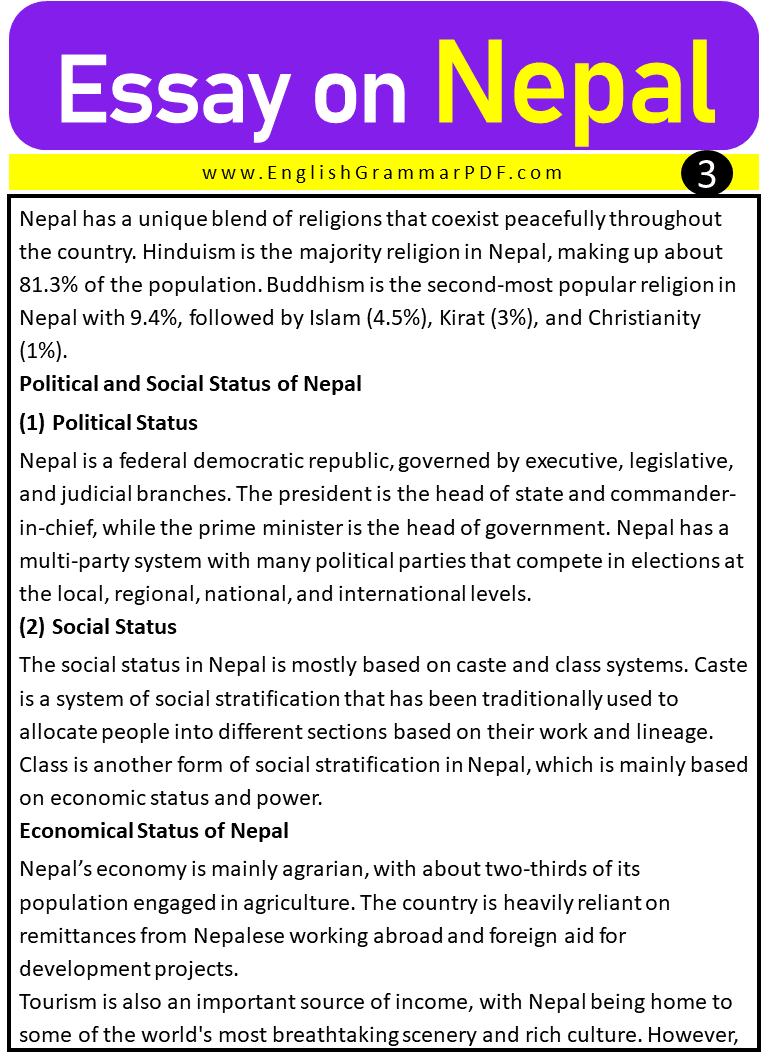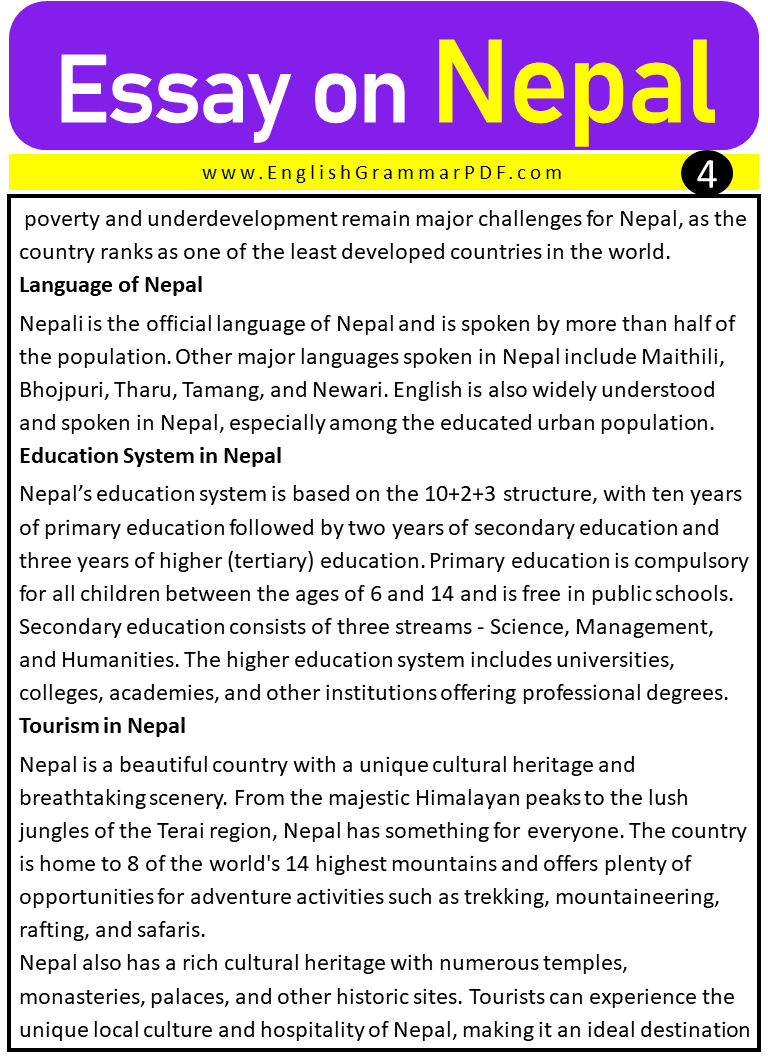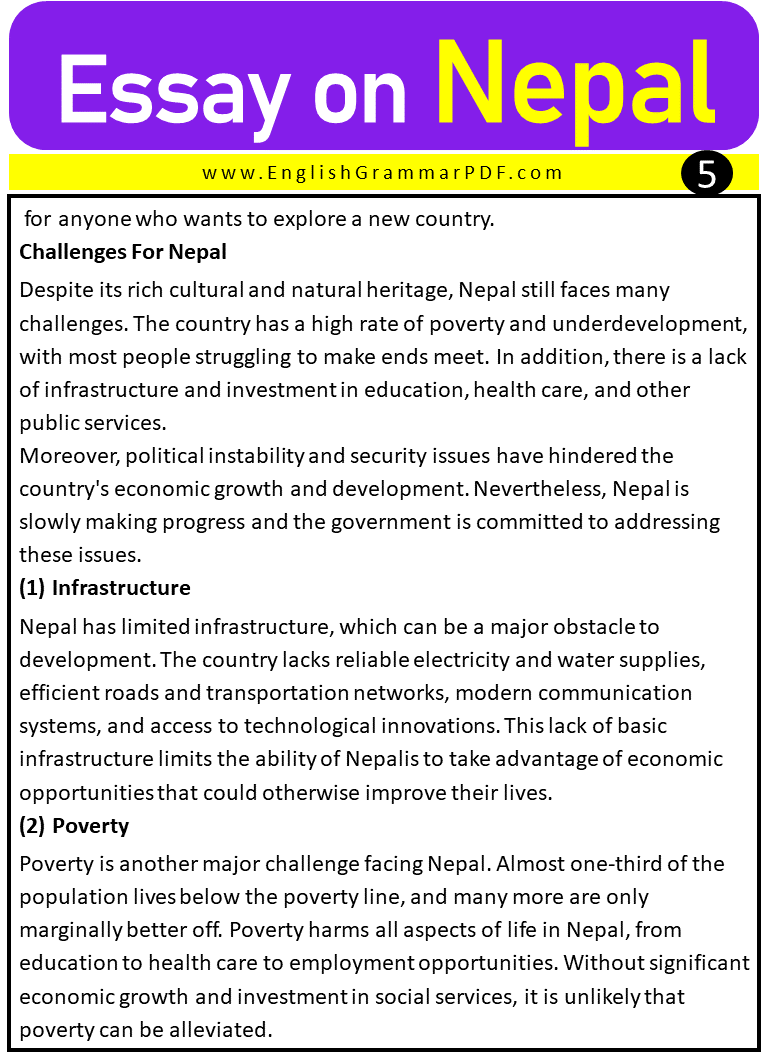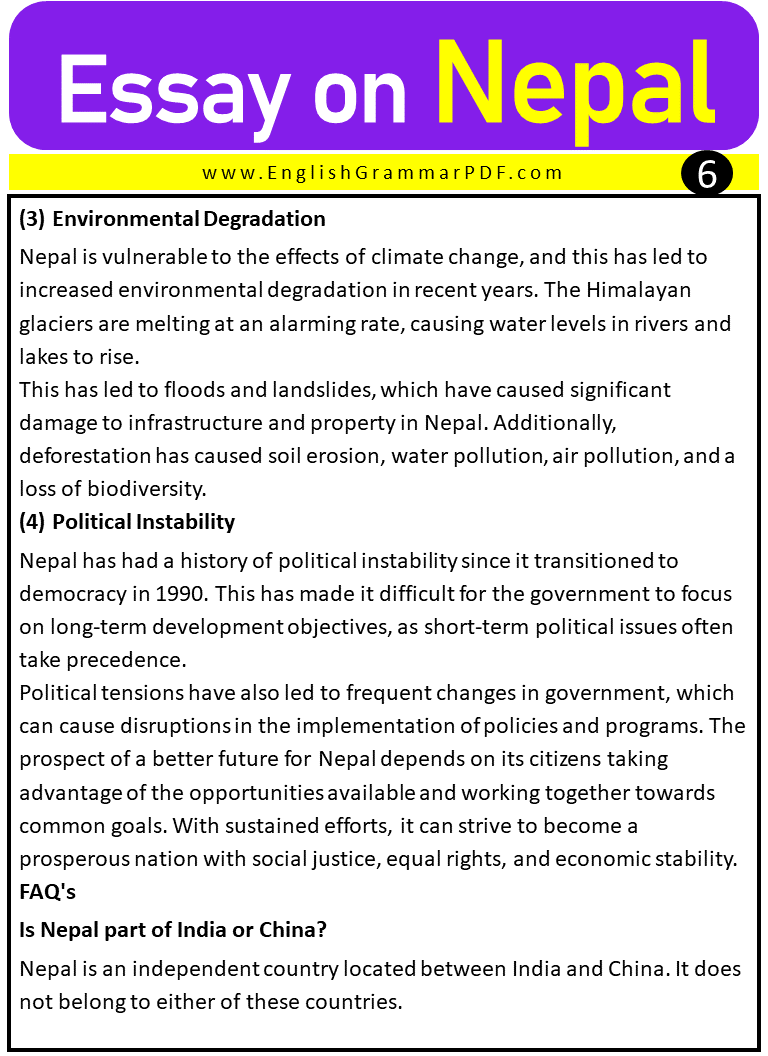Essay On Nepal
Outline of Essay:
- Introduction
- History of Nepal
- Geography of Nepal
- Climate of Nepal
- Culture of Nepal
- Religion and Religious Status of Nepal
- Political and Social Status of Nepal
- Economical Status of Nepal
- Language of Nepal
- Development and Education in Nepal
- Challenges For Nepal
- FAQ’s
Discover more:
Introduction
Nepal is a sovereign state located in South Asia. It lies mainly in the Himalayas, but also includes parts of the Indo-Gangetic Plain. With an area of 147,181 square kilometers and a population of around 30 million people, Nepal is the world’s 95th largest country by land mass and the 49th most populous country. Nepal is a multicultural, multi-ethnic, and multi-religious nation, with Hinduism as the majority religion. The official language of Nepal is Nepali.
History of Nepal
Nepal has a unique, rich history that dates back to pre-historic times. It was unified in the late 18th century, when Prithvi Narayan Shah, the ruler of Gorkha, unified many small kingdoms and principalities to form modern Nepal.
Since then, it has seen many twists and turns in its political landscape. From a monarchy system to a constitutional monarchy, to a democratic republic today – Nepal has been through it all.
Geography of Nepal
Nepal is located in South Asia, between India and China. It covers an area of 147,181 square kilometers (56,827 sq mi), with the majority of its terrain occupied by the rugged Himalayan mountain range. Nepal has eight of the world’s ten highest peaks, including Mount Everest – the tallest peak on Earth. Apart from the Himalayas, Nepal also has hilly and lowland areas in the south.
Climate of Nepal
The climate of Nepal varies from region to region. Most parts of the country have a temperate climate, with cooler temperatures in higher altitudes and warmer temperatures in lower altitudes. The highest peaks receive snowfall all year round, while the plains and valleys have a subtropical climate with hot summers and mild winters.
Culture of Nepal
Nepal is an ancient country with a rich culture that dates back centuries. The Nepalese people are known for their friendliness, hospitality, and courtesy toward visitors from around the world. The culture of Nepal is made up of many facets such as art, literature, music, dance, and cuisine. Nepal’s traditional lifestyle is based on religious values, with Buddhism and Hinduism being the two main religions.
Religion and Religious Status of Nepal
Nepal has a unique blend of religions that coexist peacefully throughout the country. Hinduism is the majority religion in Nepal, making up about 81.3% of the population. Buddhism is the second-most popular religion in Nepal with 9.4%, followed by Islam (4.5%), Kirat (3%), and Christianity (1%).
Political and Social Status of Nepal
(1) Political Status
Nepal is a federal democratic republic, governed by executive, legislative, and judicial branches. The president is the head of state and commander-in-chief, while the prime minister is the head of government. Nepal has a multi-party system with many political parties that compete in elections at the local, regional, national, and international levels.
(2) Social Status
The social status in Nepal is mostly based on caste and class systems. Caste is a system of social stratification that has been traditionally used to allocate people into different sections based on their work and lineage. Class is another form of social stratification in Nepal, which is mainly based on economic status and power.
Economical Status of Nepal
Nepal’s economy is mainly agrarian, with about two-thirds of its population engaged in agriculture. The country is heavily reliant on remittances from Nepalese working abroad and foreign aid for development projects.
Tourism is also an important source of income, with Nepal being home to some of the world’s most breathtaking scenery and rich culture. However, poverty and underdevelopment remain major challenges for Nepal, as the country ranks as one of the least developed countries in the world.
Language of Nepal
Nepali is the official language of Nepal and is spoken by more than half of the population. Other major languages spoken in Nepal include Maithili, Bhojpuri, Tharu, Tamang, and Newari. English is also widely understood and spoken in Nepal, especially among the educated urban population.
Education System in Nepal
Nepal’s education system is based on the 10+2+3 structure, with ten years of primary education followed by two years of secondary education and three years of higher (tertiary) education. Primary education is compulsory for all children between the ages of 6 and 14 and is free in public schools.
Secondary education consists of three streams – Science, Management, and Humanities. The higher education system includes universities, colleges, academies, and other institutions offering professional degrees.
Tourism in Nepal
Nepal is a beautiful country with a unique cultural heritage and breathtaking scenery. From the majestic Himalayan peaks to the lush jungles of the Terai region, Nepal has something for everyone. The country is home to 8 of the world’s 14 highest mountains and offers plenty of opportunities for adventure activities such as trekking, mountaineering, rafting, and safaris.
Nepal also has a rich cultural heritage with numerous temples, monasteries, palaces, and other historic sites. Tourists can experience the unique local culture and hospitality of Nepal, making it an ideal destination for anyone who wants to explore a new country.
Challenges For Nepal
Despite its rich cultural and natural heritage, Nepal still faces many challenges. The country has a high rate of poverty and underdevelopment, with most people struggling to make ends meet. In addition, there is a lack of infrastructure and investment in education, health care, and other public services.
Moreover, political instability and security issues have hindered the country’s economic growth and development. Nevertheless, Nepal is slowly making progress and the government is committed to addressing these issues.
(1) Infrastructure
Nepal has limited infrastructure, which can be a major obstacle to development. The country lacks reliable electricity and water supplies, efficient roads and transportation networks, modern communication systems, and access to technological innovations. This lack of basic infrastructure limits the ability of Nepalis to take advantage of economic opportunities that could otherwise improve their lives.
(2) Poverty
Poverty is another major challenge facing Nepal. Almost one-third of the population lives below the poverty line, and many more are only marginally better off. Poverty harms all aspects of life in Nepal, from education to health care to employment opportunities. Without significant economic growth and investment in social services, it is unlikely that poverty can be alleviated.
(3) Environmental Degradation
Nepal is vulnerable to the effects of climate change, and this has led to increased environmental degradation in recent years. The Himalayan glaciers are melting at an alarming rate, causing water levels in rivers and lakes to rise.
This has led to floods and landslides, which have caused significant damage to infrastructure and property in Nepal. Additionally, deforestation has caused soil erosion, water pollution, air pollution, and a loss of biodiversity.
(4) Political Instability
Nepal has had a history of political instability since it transitioned to democracy in 1990. This has made it difficult for the government to focus on long-term development objectives, as short-term political issues often take precedence.
Political tensions have also led to frequent changes in government, which can cause disruptions in the implementation of policies and programs. The prospect of a better future for Nepal depends on its citizens taking advantage of the opportunities available and working together towards common goals. With sustained efforts, it can strive to become a prosperous nation with social justice, equal rights, and economic stability.
FAQ’s
Is Nepal part of India or China?
Nepal is an independent country located between India and China. It does not belong to either of these countries.
What are some popular tourist destinations in Nepal?
Some of the most popular tourist destinations in Nepal include Kathmandu, Pokhara, Chitwan National Park, Bhaktapur Durbar Square, and Lumbini.
Which religions are practiced in Nepal?
Hinduism is the dominant religion in Nepal, followed by Buddhism and Islam. Other religious faiths such as Christianity, Jainism, and Sikhism are also practiced in the country.
What challenges does Nepal face?
Some of the main challenges that Nepal faces include a lack of infrastructure, poverty, environmental degradation, and political instability.
What is Nepali traditional food?
Some of the most popular traditional Nepali dishes include Dal Bhat (rice and lentil soup), Momo (dumplings), and Sel roti (a type of sweet bread).
Download PDF of Essay On Nepal
